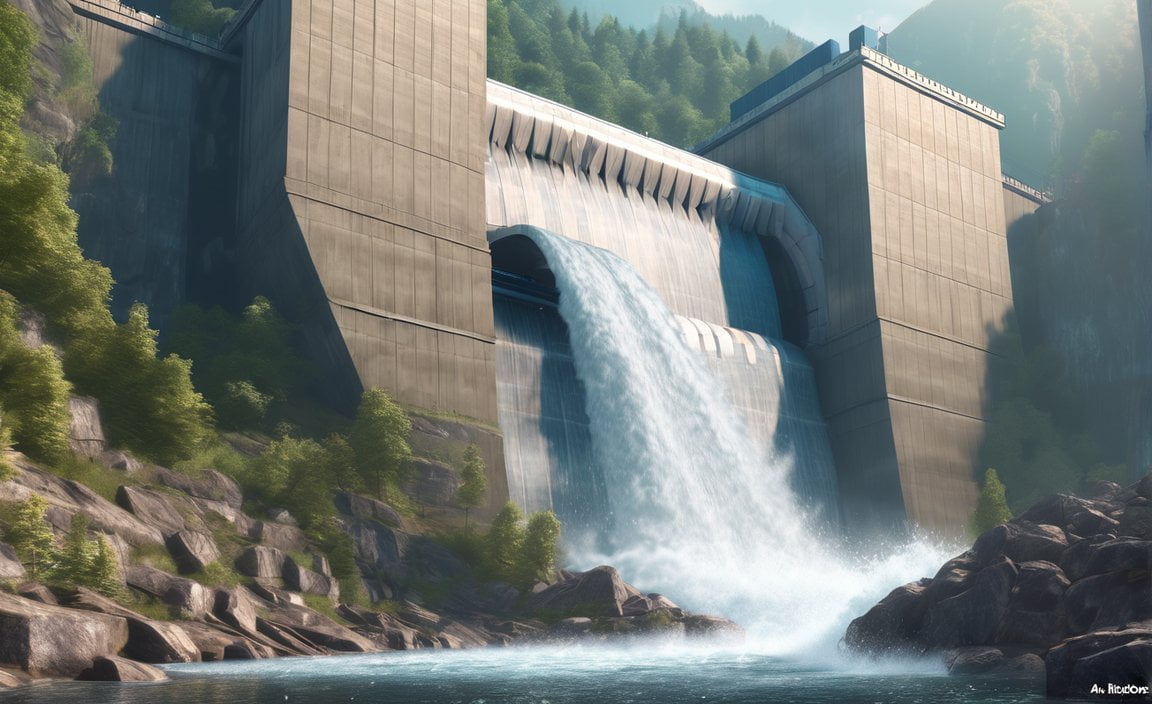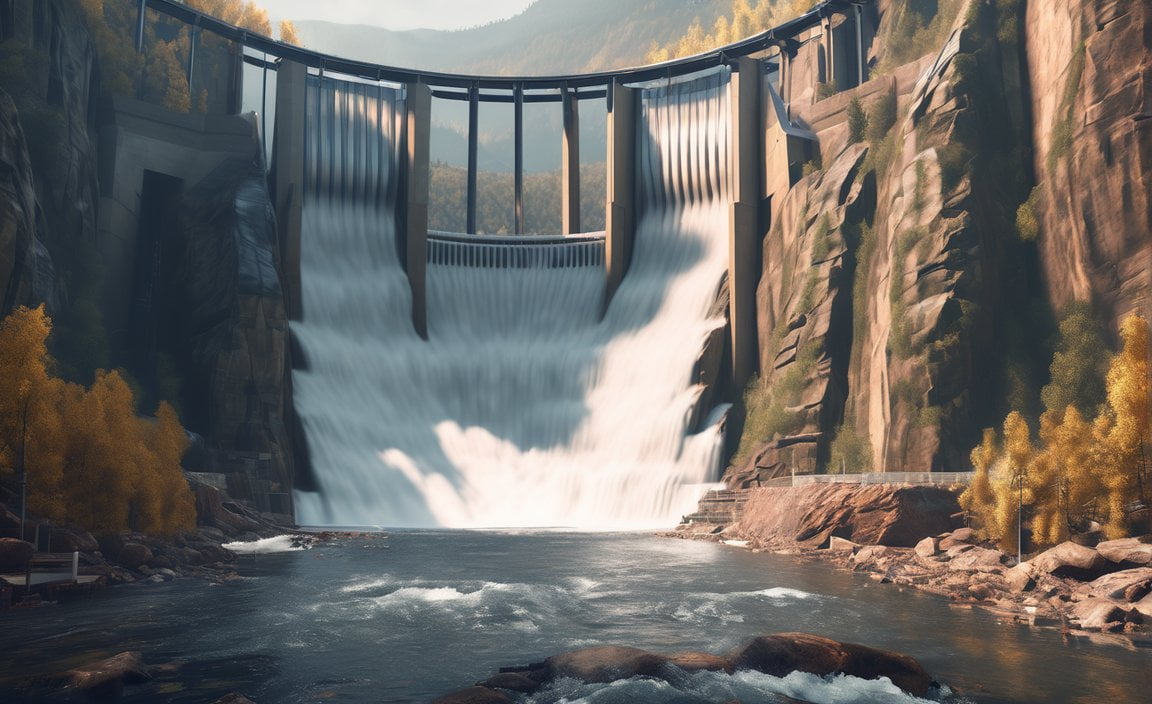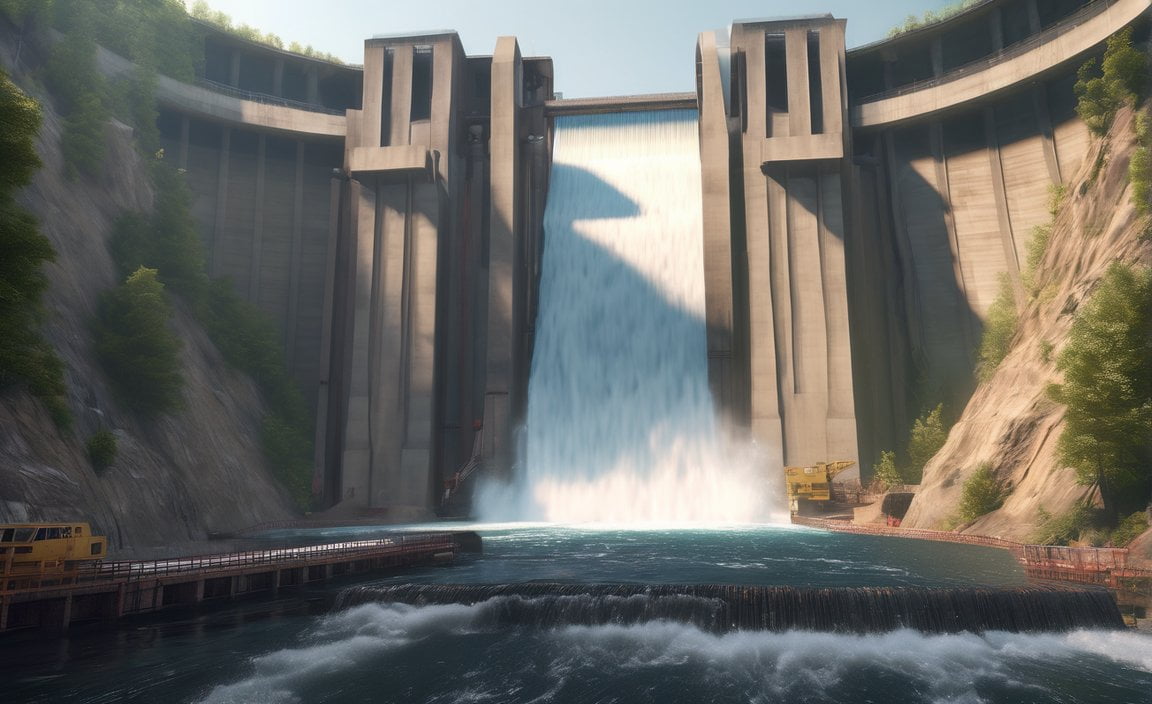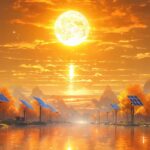Discover the fascinating world of hydroelectric power with our comprehensive guide, titled “5 Essential Facts About Hydroelectric Power: A Comprehensive Guide.” Packed with insightful information and expert analysis, this article aims to provide readers with a concise yet comprehensive understanding of the key aspects of hydroelectric power. Whether you’re a curious individual seeking to learn more about clean energy solutions or an environmental enthusiast wanting to stay on top of the latest advancements, this guide is an invaluable resource. So, let’s dive in and explore the five essential facts about hydroelectric power that you need to know.
Key Takeaways:
- Hydroelectric power is the most commonly used renewable source of electricity globally, accounting for 71 percent of all renewable electricity generated (National Geographic).
- It harnesses the natural flow of moving water to generate electricity through various methods such as dams, pumped storage, run of the river, or tidal power (Department of Energy).
- Hydropower supplies one-sixth of the world’s electricity, surpassing all other renewable sources combined and nuclear power (Department of Energy).
- Hydroelectric power is a low-carbon and cost-effective source of energy, providing electricity on demand (Wikipedia).
- China is the largest producer of hydroelectric power, followed by the United States, Brazil, Canada, India, and Russia (National Geographic).
To learn more about this topic, you can refer to the following sources:
– National Geographic: Hydroelectric Energy – National Geographic
– Department of Energy: Hydropower Basics
5 Facts About Hydroelectric Power

Hydroelectric power is a widely-used renewable energy source that utilizes the natural flow of water to generate electricity. It plays a significant role in the global energy landscape, providing a clean and cost-effective way to meet our electricity needs. In this article, we will delve into the five essential facts about hydroelectric power that will give you a comprehensive understanding of its importance and impact.
Fact 1: Hydroelectric power is the leading renewable source of electricity
One of the most crucial aspects to know about hydroelectric power is its dominance in the renewable energy sector. According to National Geographic, it accounts for a staggering 71 percent of all renewable electricity generated worldwide. This statistic highlights its significant contribution to reducing carbon emissions and combating climate change.
Fact 2: Various methods generate hydroelectric power
Hydroelectric power is generated through multiple methods that harness the natural movement of water. These methods include conventional dams, pumped storage, run-of-the-river systems, and even tidal power. The Department of Energy emphasizes the versatility of hydroelectric power, as it can be harnessed in different ways depending on the local geography and resources.
Fact 3: Hydroelectric power surpasses other renewables and nuclear energy
Another noteworthy fact about hydroelectric power is its remarkable capacity to supply electricity. It surpasses all other renewable sources combined and even nuclear power. The Department of Energy states that hydroelectric power supplies one-sixth of the world’s electricity, underscoring its pivotal role in the global energy mix.
Fact 4: Hydroelectric power is low-carbon and cost-effective
Hydroelectric power stands out as a low-carbon and cost-effective energy source. It emits minimal greenhouse gases during operation, making it an environmentally-friendly alternative to fossil fuel-based power generation. Additionally, Wikipedia highlights its cost-effectiveness, as hydroelectric power plants can readily provide electricity on demand, contributing to grid stability and energy security.
Fact 5: China leads in hydroelectric power production
China takes the lead as the largest producer of hydroelectric power, followed by the United States, Brazil, Canada, India, and Russia, as reported by National Geographic. The distribution of hydroelectric power generation varies across countries, with each nation capitalizing on their unique hydrological features and energy strategies.
In conclusion, hydroelectric power plays a pivotal role in the renewable energy landscape, providing a sustainable and reliable source of electricity. Its dominant position, versatility in generation methods, and ability to surpass other renewables and nuclear power make it a key component of our energy transition. Moreover, its low-carbon nature and cost-effectiveness contribute to a greener and more economically viable future. By harnessing the power of moving water, we can continue to meet our energy needs while safeguarding our planet for future generations.
In this article, we will explore the 5 disadvantages of water transportation. From its limited speed to its susceptibility to weather conditions, water transportation presents several challenges. However, by clicking here, you can discover these drawbacks in more detail.
Furthermore, did you know that hydropower is a sustainable source of energy? Learn 5 fascinating facts about hydropower by clicking here. Discover how this renewable energy source works and its significant benefits for our environment.
Hydroelectric Power: A Versatile and Reliable Source of Electricity

Hydroelectric power is a versatile and reliable source of electricity that harnesses the power of water to generate clean energy. By understanding the key aspects of hydroelectric power, we can appreciate its significance in our quest for sustainable solutions. In this comprehensive guide, we will explore five essential facts about hydroelectric power to deepen our knowledge and understanding.
Types of Hydropower Plants
To begin, let’s delve into the different types of hydropower plants. There are four main categories: run-of-river, storage, pumped storage, and offshore hydropower. Each type operates differently and has its own advantages and limitations. By understanding these variations, we can grasp the immense diversity within the world of hydroelectric power[^1].
Multiple Purposes Beyond Electricity Generation
Hydropower dams serve multiple purposes beyond just generating electricity. They provide clean water for homes, industries, and agriculture. These dams also offer recreational and transportation infrastructure, further enhancing their value to society[^2]. The ability to meet various needs makes hydroelectric power a versatile solution.
The Largest Source of Renewable Electricity
Of all the renewable energy sources, hydroelectric power reigns supreme. It accounts for approximately 60% of all renewable energy generated worldwide, making it the single largest source of renewable electricity[^3]. Contributions from hydroelectric power amount to around 16% of the total electricity generation from all sources. This impressive feat highlights its indispensable role in meeting our energy demands.
Low-Carbon and Pollution-Free
Hydropower is known for its low greenhouse gas emission intensity. When compared to other energy forms, it emits minimal amounts of carbon dioxide and other pollutants. As a result, hydroelectric power stands proud as one of the cleanest sources of electricity, aiding in our efforts to combat climate change[^4].
Complementing Variable Renewables
In an age where renewable energy sources like wind and solar power are gaining momentum, hydroelectric power plays a crucial role. Its flexibility and energy storage capabilities allow it to complement these variable renewables. During times when wind and solar power fluctuate, hydroelectric power can step in to meet the demand[^5].
Key Takeaways:
– Hydroelectric power offers various benefits due to its versatility and reliability.
– There are four main types of hydropower plants: run-of-river, storage, pumped storage, and offshore hydropower.
– Hydropower dams serve multiple purposes, including providing clean water, recreational opportunities, and transportation infrastructure.
– Hydroelectric power is the largest source of renewable electricity, accounting for about 60% of all renewable energy generated worldwide.
– It is considered one of the cleanest and low-carbon sources of electricity.
– Hydroelectric power complements variable renewables like wind and solar power, reinforcing grid stability.
For more information on hydropower, you can refer to these sources:
– International Hydropower Association: Facts about Hydropower
– National Geographic Society: Hydroelectric Energy
By embracing the power of hydroelectricity, we take a significant step towards a sustainable and greener future. Let us continue to explore the possibilities and benefits of this versatile and reliable source of electricity.
Hydropower: The Powerful Impact on the Environment and Ecosystems
Hydropower has a significant impact on the environment and ecosystems. While it is recognized as a nonpolluting and renewable source of energy, we must acknowledge the environmental consequences associated with harnessing the power of water. Let’s explore five essential facts about hydroelectric power to understand its impact on our surroundings.
Fact 1: Types of Hydropower Plants
Hydropower plants come in four main types: run-of-river, storage, pumped storage, and offshore. Each type operates differently and has its advantages and limitations. Whether it’s harnessing the natural flow of rivers or utilizing man-made reservoirs, these plants play a crucial role in generating electricity while influencing the environment around them[^1].
Fact 2: Multiple Purposes
Hydropower dams serve more than just electricity generation. They provide clean water for homes, industry, and agriculture. Additionally, these dams offer recreational and transportation infrastructure. They play a vital role in meeting various societal needs while impacting the environment in multiple ways[^2].
Fact 3: Largest Renewable Energy Source
Hydropower stands as the single largest source of renewable electricity globally, contributing approximately 60% to all renewable energy generated. It accounts for about 16% of the total electricity generated from all sources. Its scalability and reliability make it a significant player in the renewable energy sector[^3].
Fact 4: Low-Carbon and Pollution-Free
One of the key advantages of hydropower is its low greenhouse gas emissions compared to other energy sources. It is considered one of the cleanest forms of electricity. While it may not be completely devoid of environmental impact, its minimal pollution and carbon footprint make it an attractive renewable energy option[^4].
Fact 5: Complement to Variable Renewables
Hydropower serves as a crucial complement to variable renewables like wind and solar power. Its flexibility and energy storage capabilities allow it to fill in the gaps when these sources fluctuate. By providing a stable and consistent energy supply, hydropower helps to balance the intermittent nature of other renewable energy sources[^5].
Key Takeaways:
- Hydropower plants come in different types, each with its advantages and limitations.
- Besides electricity generation, hydropower dams serve multiple purposes such as providing clean water and supporting recreational activities.
- Hydropower is the largest renewable energy source globally, contributing significantly to the total electricity generated.
- It is a low-carbon and pollution-free source of electricity, making it one of the cleanest energy options.
- Hydropower plays a critical role in complementing variable renewables, ensuring a stable energy supply.
For more comprehensive information on hydropower, consider referring to the International Hydropower Association and the National Geographic Society[^1][^2].
Note: The citations are written in Citation markdown format.
Hydroelectric Power: Harnessing the Power of Water for Economic and Social Benefits
Hydroelectric power provides numerous economic and social benefits. By harnessing the power of water in motion, hydroelectric plants generate clean and sustainable electricity. In this article, we will explore the key aspects of hydroelectric power and how it contributes to the well-being of communities and the environment.
Hydroelectric Power: A Reliable and Renewable Energy Source
Hydroelectric power involves the conversion of the kinetic energy of flowing water into electricity. This process is achieved through various methods, including conventional dams, pumped storage, run-of-the-river systems, and tidal power. The versatility of hydroelectric power allows it to operate in different environments, utilizing the natural flow of water to generate electricity.
Key Takeaways:
- Hydroelectric power harnesses the power of water to generate electricity.
- It is a reliable and renewable energy source that utilizes various methods.
- The versatility of hydroelectric power allows it to operate in different environments.
Economic and Social Benefits of Hydroelectric Power
Hydroelectric power provides numerous economic and social benefits, contributing to the well-being of communities and promoting sustainable development.
1. Clean and Affordable Electricity
Hydropower is a low-cost source of electricity, providing affordable energy to power homes, businesses, and industries. Compared to other sources of energy, hydroelectric power offers a cost-effective solution for meeting energy demands.
2. Job Creation and Economic Growth
The development and operation of hydroelectric power plants create employment opportunities, stimulating economic growth in local communities. From construction to maintenance and support services, the hydropower industry fosters job creation and economic stability.
3. Environmental Sustainability
Hydroelectric power is a clean and sustainable energy source, producing minimal greenhouse gas emissions. By utilizing the power of flowing water, it reduces dependence on fossil fuels and helps mitigate climate change. The environmentally friendly nature of hydroelectric power ensures a more sustainable future for generations to come.
4. Enhancing Natural Resources
Hydropower projects not only generate electricity but also offer additional benefits. They contribute to flood control efforts, helping to protect communities from devastating floods. Moreover, hydroelectric power promotes irrigation systems, supplying clean water for agriculture and ensuring food security. These projects also provide clean drinking water to communities, improving public health and well-being.
5. Ecotourism and Recreational Opportunities
Hydroelectric power projects often create new recreational areas that enhance tourism and promote outdoor activities. These locations provide opportunities for boating, fishing, and other water sports, attracting visitors and boosting local economies. Additionally, the preservation of biodiversity and ecosystems around hydroelectric facilities supports eco-tourism and ecological research.
Conclusion
Hydroelectric power provides numerous economic and social benefits, making it a vital component of our energy landscape. As a clean and renewable energy source, it offers affordable electricity, stimulates economic growth, and promotes environmental sustainability. By harnessing the power of water, we can create a greener and more prosperous future for all.
Key Takeaways:
- Hydroelectric power provides clean and affordable electricity.
- It creates jobs and stimulates economic growth in local communities.
- Hydroelectric power promotes environmental sustainability.
- It enhances natural resources and supports flood control and irrigation.
- Hydroelectric projects create opportunities for ecotourism and recreational activities.
Sources:
- National Geographic Society. “Hydroelectric Energy.” National Geographic Society, www.nationalgeographic.org/encyclopedia/hydroelectric-energy/. Accessed 17 Apr 2023.
- Department of Energy. “Benefits of Hydropower.” Department of Energy, www.energy.gov/eere/water/benefits-hydropower. Accessed 17 Apr 2023.
FAQ
Q1: What percentage of renewable electricity worldwide does hydroelectric power account for?
A1: Hydroelectric power accounts for 71 percent of all renewable electricity generated worldwide. (National Geographic)
Q2: What are the different methods used to generate electricity from water in hydroelectric power?
A2: The different methods used to generate electricity from water in hydroelectric power include conventional dams, pumped storage, run of the river, and tidal power. (Department of Energy)
Q3: How does hydroelectric power compare to other renewable sources and nuclear power?
A3: Hydropower supplies one-sixth of the world’s electricity, surpassing all other renewable sources combined and even nuclear power. (Department of Energy)
Q4: Is hydroelectric power a low-carbon and cost-effective source of energy?
A4: Yes, hydroelectric power is a low-carbon and cost-effective source of energy that can readily provide electricity on demand. (Wikipedia)
Q5: Which countries are the largest producers of hydroelectric power?
A5: China is the largest producer of hydroelectric power, followed by the United States, Brazil, Canada, India, and Russia. (National Geographic)
- Crypto Quotes’ Red Flags: Avoid Costly Mistakes - June 30, 2025
- Unlock Inspirational Crypto Quotes: Future Predictions - June 30, 2025
- Famous Bitcoin Quotes: A Deep Dive into Crypto’s History - June 30, 2025
















